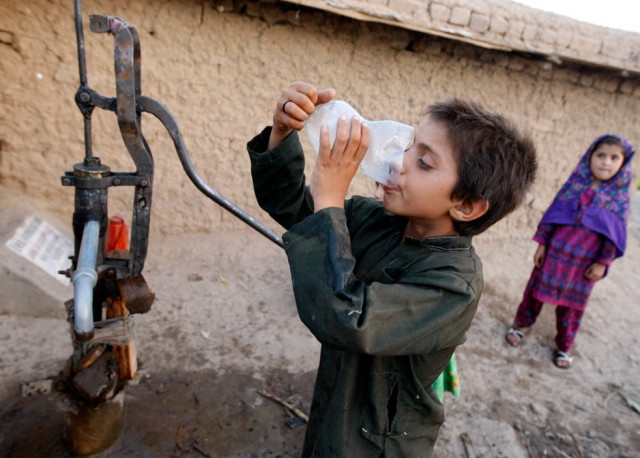Building parks is our answer to freshwater shortage
In Pakistan some communities have to walk long distances to fetch water

PHOTO: AFP
In Pakistan some communities have to walk long distances to fetch water. Our groundwater level is also declining rapidly, for example, a recent WWF-Pakistan report shows that the water table around Lahore is declining at an average rate of 1.5ft per year. On the other hand, freshwater is not plentiful in nature and it is only three per cent of the water which is, in fact, fresh. As a result, we are dependent on snowmelts and rains for our freshwater supply and this is a recurring water cycle that keeps replenishing, but only some of it. The problem is that we are polluting our freshwater resources and gradually making them unavailable.
Is Pakistan ready to run out of water?
Data collected in 2003 by World Bank suggests, in Pakistan 5.6 million tonnes of fertilisers and 70’000 tonnes of pesticides are used every year. The resources that go into the advertisement of these two not only make them appear as a necessity but also create peer pressure. Farmers use both fertilisers and pesticides without understanding the situation and end up killing crop-friendly carnivore insects as well. On the other hand, no sewage treatment plant is functioning properly in Karachi and raw sewage or untreated industrial waste is poured directly into the harbour from the metropolis. Not only does this pollute freshwater but also contaminates the naturally rich and economically critical marine ecosystem.
Besides, why is that despite having frequent floods Pakistan is still water stressed? It is because we are managing our rivers but have broken down their connections with wetlands that act as sponges to absorb flood water and reserve freshwater to protect communities. These wetlands offer a natural solution during floods. China restored its destroyed wetland ecosystem to reduce pressures from flooding. This helped them restore 2,900sq km of these lands while reconnecting about 40 lakes, increasing floodwater retention capacity to 13billion cubic metres.
Similar principles apply to an urban environment because every time it rains it halts life in big cities. Our political leaders make media appearances in wellington boots, bringing water and sanitation authorities in action, who pump this freshwater into gutters. This is an utter waste of a precious and fast diminishing resource, but they have no choice because we have insufficient green belts and parks to absorb the downpour.
Water scarcity ‘biggest threat’ to Pakistan
All our big cities are congested; everything is concrete and open spaces continue to be converted into concrete, be it for the metro line or widening of roads. Even housing societies are not generous enough when it comes to dedicating areas for parks. For instance, Bahria Town develops mini zoos but no large parks. Most housing societies develop expensive golf courses or small parks that are insufficient in managing rainwater or providing shelter to urban biodiversity.
We need more and larger parks as they have multiple functions which include helping groundwater recharge, protecting urban biodiversity, managing rainwater, acting as carbon sinks and providing recreation. For instance, London is a big and old city with some of the largest parks, Regent Park with an area of 166ha and Hyde Park with an area of 142ha, and lakes offering refuge to migratory waterfowl. In comparison, Lahore’s Racecourse Park (Jilani Park) is just about 35ha and Lawrence Garden which was initially 71ha has now been reduced to about 56acres. In fact, Shalimar Gardens was also threatened by the Orange Line construction until civil society members knocked the doors of the Lahore High Court.
Other ways to save freshwater is to make it mandatory to collect rainwater from rooftops and use it for washing cars, watering lawns and using the water in toilets. Last year, France passed a law that requires all new buildings to have green roofs or solar panels. This will reduce our drinkable water demand for non-potable applications.
Dr Uzma Khan is an endangered species management specialist.



















COMMENTS
Comments are moderated and generally will be posted if they are on-topic and not abusive.
For more information, please see our Comments FAQ